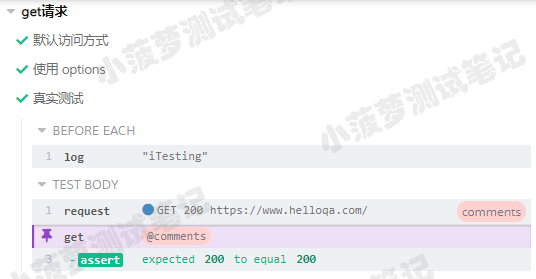Cypress系列(68)- request() 命令详解
如果想从头学起Cypress,可以看下面的系列文章哦
https://www.cnblogs.com/poloyy/category/1768839.html
作用
发起一个 HTTP 请求
语法格式
cy.request(url)
cy.request(url, body)
cy.request(method, url)
cy.request(method, url, body)
cy.request(options)
参数说明
url
请求 URL
cy.request() 在 cy.visit() 后面
// 先访问某个 url cy.visit('http://localhost:8080/app') // 请求 url 是 http://localhost:8080/users/1.json cy.request('users/1.json')
设置了 baseUrl,且 cy.request() 在 cy.visit() 前面
cypress.json
// cypress.json { "baseUrl": "http://localhost:1234" }
测试代码
// url 是 http://localhost:1234/seed/admin cy.request('seed/admin')
备注
如果 cypress 无法确定 host,它将抛出错误
body
- 请求正文,不同接口内容,body 会有不同的形式
- Cypress 设置了 Accepts 请求头,并通过 encoding 选项序列化响应体
method
请求方法,没啥好说的,默认是 GET
options

GET 请求的栗子
context('get请求', function () {
it('默认访问方式', function () {
cy.request('http://www.helloqa.com')
});
it('使用 options', function () {
cy.request({
method: 'get',
url: 'http://www.helloqa.com'
})
});
// .request() 常常和别名 .as() 一起使用,用来进行接口返回值的断言
it('真实测试', function () {
cy.request({
method: 'get',
url: 'https://www.helloqa.com'
}).as('comments')
cy.get('@comments')
.then((response) => {
expect(response.status).to.be.eq(200)
})
});
})
测试结果

.request() 返回值

包含以下属性
- status
- body
- headers
- duration
.request() 别名后通过 .get() 的返回值

包含以下属性
- status
- body
- headers
- duration
- statusText
- allRequestResponses
- requestHeaders
- redirects
- isOkStatusCode
使用 .request() 代替 .visit() 的栗子
官方有那么一句话
有时候,cy.request() 测试页面的内容要比 cy.visit() 更快,然后等待整个页面加载所有资源
通过 .visit() 测试需要登录才能访问的页面
const username = 'jane.lane' const password = 'password123' it('使用 visit', function () { // 相当于 UI 界面操作 cy.visit('') // 登录操作 cy.get("input[name=username]").type(username) cy.get("input[name=password]").type(password) cy.get("form").submit() // 会跳转至需要登录才能访问的页面 cy.get("h1").should("contain", "jane.lane") });
测试结果

通过 .request() 测试需要登录才能访问的页面
it('request代替visit', function () {
// 通过接口层面去访问页面
// 请求页面
cy.request('/login')
.its('body')
.should('include', '<p>In this recipe we:</p>')
// 登录请求
cy.request({
method: 'post',
url: '/login',
// 表单格式的请求
form: true,
body: {
username: 'jane.lane',
password: 'password123'
}
})
// 访问需要登录之后才能访问的页面
cy.request('/dashboard')
.its('body')
.should('include', 'jane.lane')
});
测试结果

官方重点
通常,一旦对登录进行了适当的e2e测试,就没有理由继续使用 cy.visit() 登录并等待整个页面加载所有关联的资源,然后再运行其他命令,这样做可能会减慢我们整个测试套件的速度
轮询发出请求的栗子
背景
- 当轮询服务器以获取可能需要一段时间才能完成的响应时,此功能很有用
- 如何做:创建一个递归函数
测试代码
function req() { cy .request('/') .then((resp) => { if (resp.status === 200) // 请求成功则退出轮询 return // 递归 req() }) } context('轮询request', function () { it('默认访问方式', function () { cy.visit('http://localhost:7077/') // 轮询前的操作 cy.get("form").click() // 轮询请求 .then(() => { req() }) }); })
关于 .request() 的注意事项
Debugging
- 通过 .request() 发出的请求不会出现在开发者工具(F12)网络一栏中
- Cypress 实际上并未从浏览器发出XHR请求
- 实际上是从 Cypress Test Runner(在Node中)发出HTTP请求
- 因此,不会在开发人员工具中看到该请求
Cookie
- 通过 .request() 发出的请求,Cypress 会自动发送和接收 Cookie
- 在发送 HTTP 请求之前,如果请求来自浏览器,Cypress 会自动附加本应附加的 Cookie
- 此外,如果响应具有 Set-Cookie 标头,则这些标头将自动在浏览器 Cookie 上重新设置
- 换句话说,cy.request() 透明地执行所有基础功能,就好像它来自浏览器一样
标签:
Cypress




【推荐】国内首个AI IDE,深度理解中文开发场景,立即下载体验Trae
【推荐】编程新体验,更懂你的AI,立即体验豆包MarsCode编程助手
【推荐】抖音旗下AI助手豆包,你的智能百科全书,全免费不限次数
【推荐】轻量又高性能的 SSH 工具 IShell:AI 加持,快人一步
· go语言实现终端里的倒计时
· 如何编写易于单元测试的代码
· 10年+ .NET Coder 心语,封装的思维:从隐藏、稳定开始理解其本质意义
· .NET Core 中如何实现缓存的预热?
· 从 HTTP 原因短语缺失研究 HTTP/2 和 HTTP/3 的设计差异
· 周边上新:园子的第一款马克杯温暖上架
· 分享 3 个 .NET 开源的文件压缩处理库,助力快速实现文件压缩解压功能!
· Ollama——大语言模型本地部署的极速利器
· 使用C#创建一个MCP客户端
· 分享一个免费、快速、无限量使用的满血 DeepSeek R1 模型,支持深度思考和联网搜索!